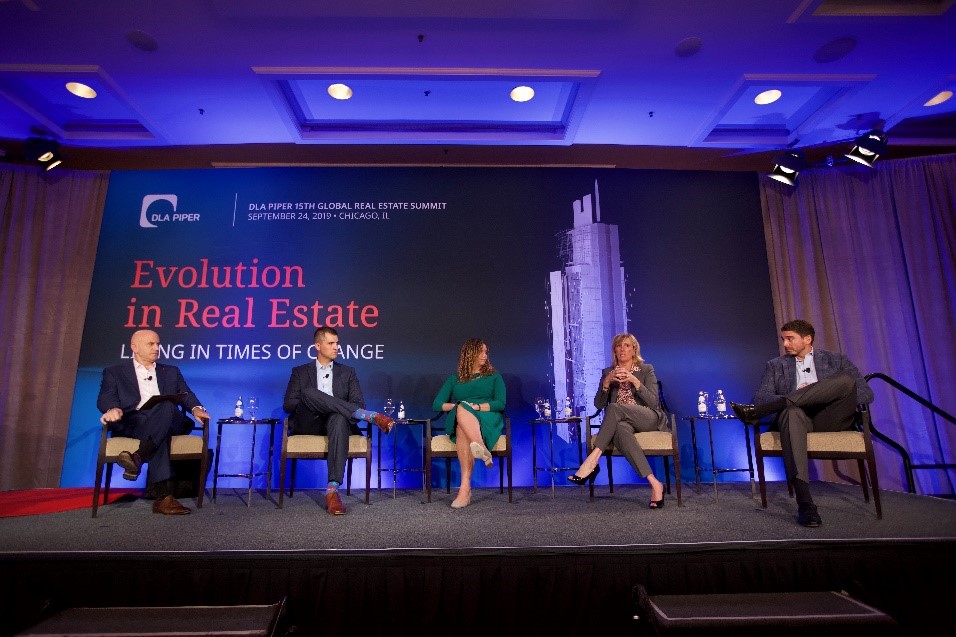Sliding Doors: Examining Tomorrow's Adaptable Real Estate Environments

What does the office of the future look like? Is it how we think of office spaces today?
DLA Piper’s 2019 Global Real Estate Summit brought together leaders from multiple areas of the real estate industry. One session, Innovating, Disrupting and Commingling Space Environments, included a diverse group of individuals – real estate owners, users and a facilitator of office space – to discuss how the quickly evolving purposes of different environments are leading to new ideas about how to make office spaces effective.
Moderated by Mitchell Schear, Executive Partner at Camber Creek, the panel covered a wide range of perspectives on how real estate will be created differently in the future, given the evolving need for properties to be a combination of flexible, experiential and data driven.
Flexibility Is Not Optional
Far from providing a straight-forward, traditional office design, real estate environments now have to accommodate a constantly shifting number of activities and priorities. In fact, the DLA Piper Annual State of the Market Survey found 51 percent of respondents believe urban/transit-oriented mixed-use development presents the most attractive opportunity for real estate investors in the next 12 months, an eight-percent uptick from the previous survey.
Peter Barnett, Real Estate Strategy Leader at PwC, explained how tenant desires have changed. For example, PwC has a property that includes a mother’s suite, a yoga studio, a wellness center, showers, communal meeting spaces, outdoor patios, indoor libraries and parks. As Barnett shared, PwC decided to invest in these amenities because it is what employees expect of a modern, global employer.
Laura Hines-Pierce, Managing Director of Hines, shared that there are opportunities for commingling across asset classes. She predicted that demands for flexibility are going to become much more prevalent in the future: “In the UK and Asia, our industrial tenants are looking for some of the same types of amenities that we saw ten years ago in [corporate] offices,” she said. “They [also] have human capital that they are trying to retain and keep engaged.”
Jodie McLean, CEO of Edens, attributed her company’s success to the nimbleness of their designs. “Our space has to be so flexible because the ultimate consumer wants something different,” she said. McLean went on to share that Edens’ retail spaces are adaptable for multi-purpose use from event spaces to board rooms.
Whether it is a residential, retail or coworking environment, the panelists agreed that in order to keep a space relevant, it must be adaptable to rapidly changing needs.
To Disrupt, Focus on the Experiential
According to Barnett, PwC concentrated largely on usage ten years ago, but priorities have shifted. “We are now focused so much more heavily on what is the [employee] experience within the space,” he said.
Ryan Simonetti, Co-Founder and CEO of Convene, shared a larger trend that mirrored Barnett’s sentiment. “Companies are going to outsource more and insource less,” he said. “As this trend toward outsourcing happens, it is putting a tremendous amount of pressure on the building owner to respond and to offer different types of experiences and amenities.”
Experiences include everything from the live music offered in some of the districts that Edens operates to the exclusive options provided by Convene. Whatever it is, conversations at the summit touched upon the important role experiences will play in the future of commercial real estate (CRE), and this [what is ‘this’?] was no exception.
Barnett pointed out that the demand for experiences will be a huge opportunity for some companies in the future. “How can we deliver that great campus-like list of amenities and experiences to smaller companies or smaller blocks of space or smaller uses?” he asked. “That is a huge opportunity.”
The Challenges and Opportunities of the Data-Enabled
Data was also an important theme at the 2019 Global Real Estate Summit and in the 2019 State of the Market Survey. As one survey respondent noted, they were most excited about “technology in real estate, from resource management, utilization and human-centric data” in the year ahead when it comes to CRE.
Hines-Pierce described the situation today for many in real estate and said, “We are living in a moment of already-but-not-yet.” She agreed that data is a major trend and noted that her company has more than $100 billion in assets under management. “The amount of data that is flowing through those assets is absolutely staggering,” she stated. “Where do we start?”
According to McLean, one way that Edens has used this information is by combining social media impressions, retail data and other information streams with heat maps. With this, the company can determine if a capital investment is actually driving human behavior.
This combination of technology, data and flexibility demonstrated the strength in the multifaceted approaches the panel discussed.
New Investments, New Relationships
All the panelists agreed that tomorrow’s CRE landscape will be vastly different than it is today. To survive, companies will need to question fundamental aspects of their business.
After noting that the rapid rate of change in today’s CRE market makes it difficult to decide where to deploy capital, Simonetti shared his strategy at Convene: invest in technology, which “can move faster than brick and mortar can move,” as he noted. “We are spending what a software company would spend on technology,” he said, estimating the amount at seven percent of the company’s gross revenue.
McLean also weighed in on the changing nature of landlord and tenant relationships. “It used to be we could build, we could lease, and the best relationship we would have with any retail partner is that we collect the checks on time and they never have to call us about a roof leak. That is forever gone,” she said. “This is an ongoing, true relationship.”
